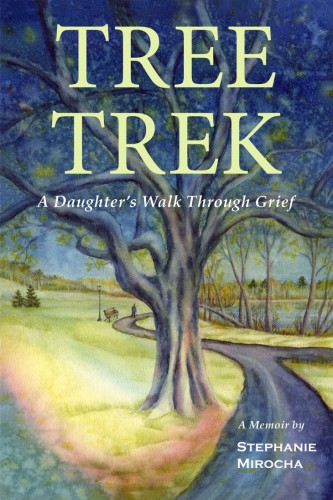by Stephanie Mirocha
Holy Cow! Press, 2025
In the introduction of Tree Trek: A Daughter’s Walk Through Grief, Stephanie Mirocha writes, “This book is the story of losing my father, that pillar of my life, and of trees, the silent partners who stood by me along the way.” In this memoir, Mirocha fulfills a promise she made to her father as he was dying of cancer: that she would keep writing. After his death, her grief pulls her into action and she sets to work reviving her father’s passion project, which he called “Tree Treks.”
Mirocha’s father, Chet, was a dedicated plant pathologist at University of Minnesota, where he conducted research on fungi that caused grains to spoil. He was also an enthusiastic naturalist. After retiring, he focused on trees, developing a deep connection with Como Regional Park in his neighborhood in St. Paul, Minnesota. Chet’s enthusiasm led him to engage with the Park Committee and organize annual “Tree Treks,” where he guided visitors in identifying various tree species, igniting their curiosity and answering their questions. He selected 18 trees in the park to be part of a self-guided trek and attached metal tags to their bark with the trees’ common and scientific names, encouraging passersby to learn more about the local flora.
“My heart led me to realize that I very much wanted to pick up my dad’s legacy and continue where he had left off,” Mirocha reflects as she undertakes the vigorous work of walking in her father’s footsteps, prying out worn labels covered in “rivulets of pitch” from the trees her father mapped out nearly two decades earlier to polish and re-attach them. The winter after her dad’s death, the Park Committee approved Mirocha’s request to fund a Tree Trek revival, and she began adding trees beyond the original 18. A particularly productive day of tagging added 38 trees to the map.
Tree Trek: A Daughter’s Walk Through Grief is a multifaceted work that serves as both a natural history tour and an emotional journey. Mirocha, an artist by trade, has a lifelong relationship with nature – camping, skiing, and hiking, often with her father – but had only a modest understanding of trees before taking on his project. As she shares her discoveries, such as the fact that white and red cedars aren’t true cedars, and that black locusts have been around since the Pleistocene, readers feel as though they are learning alongside her.
Although Mirocha and her father were very close, she realizes she did not know all the people he connected with. During her training to become a Master Naturalist, she meets a woman named Linda, who had been a close friend of her father for years. Chet mentored Linda in skiing, teaching her how to telemark and guiding her through tough conditions. For years, they were part of a larger ski group that traveled hut-to-hut in Colorado. Mirocha confronts the painful reality that her father’s life encompassed experiences beyond her understanding. “Why had all this flown so long under my radar?” she asks as she processes all the different versions of her father that she encounters after his death. “Why didn’t I make these connections sooner?”
Tree Trek is a tender and beautifully crafted account of a daughter navigating her grief while discovering the depth of her father’s life and the enduring love that remains even after loss. At just 112 pages, its brevity, relatable themes, and conversational style make it an accessible read. With its raw emotion, it is a poignant addition to the literature on grief and the healing power of nature.


